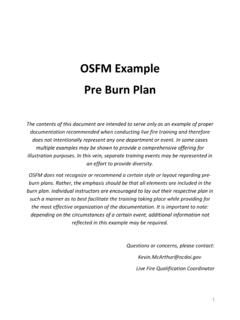Transcription of Region 9 Fisheries Monthly Highlights
1 Alexander B. Grannis Commissioner New York State Department of Environmental Conservation Division of Fish, Wildlife and Marine Resources, Region 9 182 E. Union, Suite 3, Allegany, New York 14706-1328 Phone: (716) 372-0645 Fax: (716) 372-2113 Website: Region 9 Fisheries Monthly Highlights September to October, 2009 Issue Priorities: Safeguard New York=s Unique Natural Assets RESEARCH AND MONITORING Biologists Monitor Affects of Manure Spill Fisheries staff electrofished a small tributary of Oatka Creek to determine if trout still occurred there following a CAFO manure spill.
2 Although trout had been collected from the stream several years ago, none were collected during the post-spill collections. No discoloration or smell was observed during the surveys. Region 9 Scott Cornett 716-372-0645 Chautauqua Lake Fisheries Assessment Fisheries staff completed the fall electrofishing assessment for bass, walleye and muskellunge. Both largemouth and smallmouth bass were abundant at most sites. Walleye, although not approaching historical levels of abundance, showed either good survival of from stocking or an adequate natural hatch in 2008.
3 Region 9 Mike Clancy 716-372-0645 PROTECTION Frog Island Design in the Niagara River Biologists Galati and Wilkinson participated in meetings to discuss the design for the Frog Island/Wetland habitat improvement project (HIP) in the Upper Niagara River. The project consists of a new complex of emergent and submergent aquatic vegetation in an existing five acre area located between Strawberry Island and Motor Island that currently supports only minimal aquatic vegetation. The primary goal is to protect an emergent/submergent aquatic habitat that is being eliminated along the river due water fluctuations, ice and recreational activities.
4 The project is one of about a dozen habitat improvement projects that were negotiated as part of the settlement for the New York Power Authority (NYPA) Niagara Power Project. Region 9 Joe Galati and Mike Wilkinson 716-372-0645 Habitat Restoration in the Union Ship Canal/Buffalo Harbor Biologists Galati, McKeown and Wilkinson met with members of the Niagara Greenway Ecological Committee to discuss plans for aquatic habitat restoration at the Union Ship Canal in Buffalo Harbor. Following remediation of contaminants (removal/capping), shallow water-vegetated zones will be enhanced for fish communities.
5 Region 9 Joe Galati 716-372-0645 DEC Biologist Directs Junior College Class in Stream Protection Biologist Galati gave a field presentation on stream restoration/enhancement techniques to a Jamestown Community College honors class along a 1,000 foot reach of Chautauqua Creek that was stabilized/enhance to provide habitat for migrating steelhead. Region 9 Joe Galati 716-372-0645 RESTORATION Niagara River Fish Community and Habitat Considered Impaired Biologist Wilkinson participated in a meeting of the Niagara River Remedial Action Committee (RAC) to discuss the status of fish populations in the Niagara River.
6 The history of loss/degradation of near shore, shallow-water aquatic habitats in the Niagara River is very extensive, suggesting that fish populations should be classified as impaired . Region 9 Mike Wilkinson 716-851-7010 Niagara River Juvenile Muskellunge Sampling Continues Fisheries staff, including Todd, McKeown, Wilkinson and Sztukowski spent several days electrofishing for young-of-year muskellunge in the Upper Niagara River and Buffalo Harbor. Survey results will be used to assess relative abundance of young muskellunge. Region 9 Mike Wilkinson 716-851-7010 Gilt Darters Shipped to Pennsylvania Gilt Darters Shipped to Tennessee for Propagation Biologists Clancy and McKeown, assisted by Pa Fish Commission biologists, collected gilt darters (extirpated from New York) from the Allegheny River in Pennsylvania (near East Brady).
7 The darters were overnight shipped to a laboratory in Tennessee for subsequent breeding. If the artificial propagation is successful the offspring will be stocked in the AllegRiver iheny n New York State. Region 9 Mike Clancy 716-372-0645 McKinstry Creek Stream Restoration Project Biologist Galati met with DOT staff and their consultants to assess the damage from the August 9th flood to a 2,500 foot reach of McKinstry Creek, a trout spawning stream. The stream was part of a mitigation enhancement project for impacts of the Rt. 219 Thruway. Some modifications to the original design were apparent following the storm that will be corrected by NYS-DOT.
8 Region 9 Joe Galati 716-372-0645 Cattaraugus Creek Stream Restoration Project Withstands Record August Floods Biologist Galati partnered with NYS-DOT in the design of a bank stabilization project to protect the Rt 16 Bridge while enhancing fish holding habitat by using engineered rock riffles, bend-way weirs and sloped/rip rapped banks. The project was proposed as an alternative to straightening of the channel and placement of vertical banks. During the high-water event the structures worked as intended, with desired reductions in energy and a concentration of flows in the center of the channel towards the bridge opening.
9 As vegetation plantings become established they will provide additional cover for aquatic and terrestrial life. Region 9 Joe Galati 716-372-0645 RESOURCE MANAGEMENT Famed Wiscoy Creek Trout Populations Evaluated In August, 2009, DEC Region 9 Fisheries staff with the help of angler volunteers sampled the wild brown trout populations in Wiscoy Creek and two of its major tributaries, Trout Brook and the N. Branch Wiscoy Creek. Fifteen sites were sampled overall and these sites duplicated ones done in 2006. Angler volunteers contributed 63 days of effort to help us with the sampling.
10 For the 10 sites sampled on Wiscoy Creek, the number of yearling and older wild brown trout/mile ranged from 84/mile to 1,581/mile with an average of 956/mile. This is considerably lower than was found in 2006 (1,432/mile). Except for a one mile long catch and release section, the stream is managed with a 10 minimum size and 3 fish/day limit. The average number of trout >10 /mile (legal size) in 2009 was 233, while in 2006 it was 404. While fewer trout were found in 2009 than in 2006, we did find more, larger trout, with the average number of trout >12 (115/mile) and the number >14 (38/mile) being somewhat higher than in 2006 (93/mile and 20/mile, respectively).






